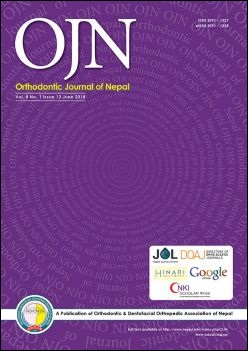Assessment of Facial Golden Proportions in Chinese Adults in Hunan Province
DOI:
https://doi.org/10.3126/ojn.v8i1.21344Keywords:
Class I malocclusion, facial esthetics, golden proportion, soft tissue analysisAbstract
Introduction: The interest of facial esthetics is growing in orthodontics. Golden proportion has been intriguing in the field of esthetics. There is a need of evaluation of facial golden proportions in various population groups.
Objective: To evaluate the relationship between facial parameters and golden proportion among patients for better treatment planning.
Materials & Method: Cross-sectional study design was used. Out of 356 pre-treatment frontal photographs, skeletal and dental Class I (n=186) were differentiated on the basis of 0.7°≤ANB≤4.7° and molar relationship. Then samples were stratified according to research criteria (Class I=159). After standardization of photographs, printing was done. The landmarks were plotted on photographic prints and parameters were measured manually. Analysis was done using SPSS version 20.0.
Result: Most of the facial height proportions TR-ME:LC-ME (1.66±.08), LC-ME:TR-LC (1.54±.09), TR-LN:LN-ME(1.58±.16),LC-CH:CH ME(1.57±.16) in frontal photographs of Class I were more close to the golden proportion. However, facial width proportions showed deviation from the golden proportion.
Conclusion: The vertical proportions in the patients showed closer to the golden proportion compared to the width proportions, indicating more soft tissue balance in vertical height.
Downloads
Downloads
Published
How to Cite
Issue
Section
License
Copyright © held by Orthodontic & Dentofacial Orthopedic Association of Nepal
- Copyright on any research article is transferred in full to the Orthodontic & Dentofacial Orthopedic Association of Nepal upon publication in the journal. The copyright transfer includes the right to reproduce and distribute the article in any form of reproduction (printing, electronic media or any other form).
- Articles in the Orthodontic Journal of Nepal are Open Access articles published under the Creative Commons CC BY License (https://creativecommons.org/licenses/by/4.0/)
- This license permits use, distribution and reproduction in any medium, provided the original work is properly cited.




